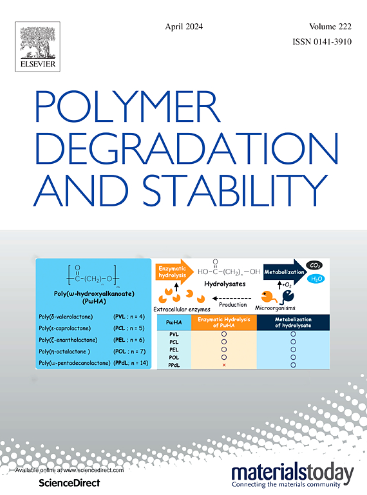Creation of sequence-regulating polyhydroxyalkanoate (PHA) synthases with improved thermostability using a full consensus design for the biosynthesis of 2-hydroxyalkanoate-based PHA block copolymers
IF 6.3
2区 化学
Q1 POLYMER SCIENCE
引用次数: 0
Abstract
Engineered polyhydroxyalkanoate (PHA) synthase PhaCAR is a chimeric enzyme composed of PhaCs from Aeromonas caviae and Ralstonia eutropha (formally Cupriavidus necator). The enzyme has a broad substrate scope and unique sequence-regulating capacity: spontaneous synthesis of various block copolymers. This study aimed to acquire new sequence-regulating PHA synthases with a broader substrate scope and improved thermal stability. To meet this goal, artificial PHA synthases were designed using the full consensus design (FCD) algorithm. Based on amino acid sequences of PHA synthases with homology to PhaC from R. eutropha in the database, four artificial PHA synthases, FcPhaC1, FcPhaC2, FcPhaC4, and FcPhaC5, were created and expressed in Escherichia coli together with the monomer-supplying enzyme. Cells were cultivated with the supplementation of monomer precursors in the medium. As a result, these four FcPhaCs synthesized poly(3-hydroxybutyrate) [P(3HB)], although polymer production was slightly lower than that obtained using PhaCAR, indicating that the algorithm successfully designed functional enzymes. FcPhaC1, FcPhaC4, and FcPhaC5 remained active after isothermal treatment at 60 °C for 30 min, whereas PhaCAR and FcPhaC2 were inactivated. Therefore, the artificial PhaCs possessed improved thermal stability compared to PhaCAR. The four FcPhaCs synthesized poly(glycolate-co-3HB) [P(GL-co-3HB)] with a block sequence as well as PhaCAR. FcPhaC4 exhibited the highest GL fraction in P(GL-co-3HB) among the PhaCs tested. FcPhaC4 synthesized P(3HB)-b-P(2-hydroxybutyrate) and P(3HB)-b-polylactate, indicating its broad substrate scope. These results demonstrated the effectiveness of the FCD approach for creating sequence-regulating PHA synthases applicable to a wide range of polymer syntheses.
利用基于2-羟基烷酸酯的PHA嵌段共聚物生物合成的完全共识设计,创建具有改善热稳定性的序列调节聚羟基烷酸酯(PHA)合成酶
工程聚羟基烷酸酯合成酶(PhaCAR)是一种由caviae气单胞菌(Aeromonas caviae)和Ralstonia eutropha (Cupriavidus necator)中的PHA组成的嵌合酶。该酶具有广泛的底物范围和独特的序列调节能力:自发合成各种嵌段共聚物。本研究旨在获得新的具有更广泛底物范围和更高热稳定性的序列调节PHA合成酶。为了实现这一目标,采用全共识设计(FCD)算法设计人工PHA合酶。根据数据库中与PhaC同源的PHA合成酶氨基酸序列,构建了4个人工PHA合成酶FcPhaC1、FcPhaC2、FcPhaC4和FcPhaC5,并与该供单体酶一起在大肠杆菌中表达。在培养基中添加单体前体培养细胞。结果,这4种FcPhaCs合成了聚(3-羟基丁酸酯)[P(3HB)],尽管聚合物产量略低于使用PhaCAR获得的聚合物产量,表明该算法成功设计了功能酶。FcPhaC1、FcPhaC4和FcPhaC5在60℃恒温处理30 min后仍保持活性,而PhaCAR和FcPhaC2则失活。因此,与PhaCAR相比,人工PhaCs具有更好的热稳定性。四个FcPhaCs合成了聚(乙醇酸-co- 3hb) [P(GL-co-3HB)]和PhaCAR。在所测的PhaCs中,FcPhaC4在P(GL-co- 3hb)中的GL分数最高。FcPhaC4合成P(3HB)-b-P(2-羟基丁酸酯)和P(3HB)-b-聚乳酸酯,表明其底物范围广泛。这些结果证明了FCD方法在创建序列调节PHA合成酶方面的有效性,该合成酶适用于广泛的聚合物合成。
本文章由计算机程序翻译,如有差异,请以英文原文为准。
求助全文
约1分钟内获得全文
求助全文
来源期刊

Polymer Degradation and Stability
化学-高分子科学
CiteScore
10.10
自引率
10.20%
发文量
325
审稿时长
23 days
期刊介绍:
Polymer Degradation and Stability deals with the degradation reactions and their control which are a major preoccupation of practitioners of the many and diverse aspects of modern polymer technology.
Deteriorative reactions occur during processing, when polymers are subjected to heat, oxygen and mechanical stress, and during the useful life of the materials when oxygen and sunlight are the most important degradative agencies. In more specialised applications, degradation may be induced by high energy radiation, ozone, atmospheric pollutants, mechanical stress, biological action, hydrolysis and many other influences. The mechanisms of these reactions and stabilisation processes must be understood if the technology and application of polymers are to continue to advance. The reporting of investigations of this kind is therefore a major function of this journal.
However there are also new developments in polymer technology in which degradation processes find positive applications. For example, photodegradable plastics are now available, the recycling of polymeric products will become increasingly important, degradation and combustion studies are involved in the definition of the fire hazards which are associated with polymeric materials and the microelectronics industry is vitally dependent upon polymer degradation in the manufacture of its circuitry. Polymer properties may also be improved by processes like curing and grafting, the chemistry of which can be closely related to that which causes physical deterioration in other circumstances.
 求助内容:
求助内容: 应助结果提醒方式:
应助结果提醒方式:


